Trad Climbing 101: Here’s How You Get Started (2024 Guide)
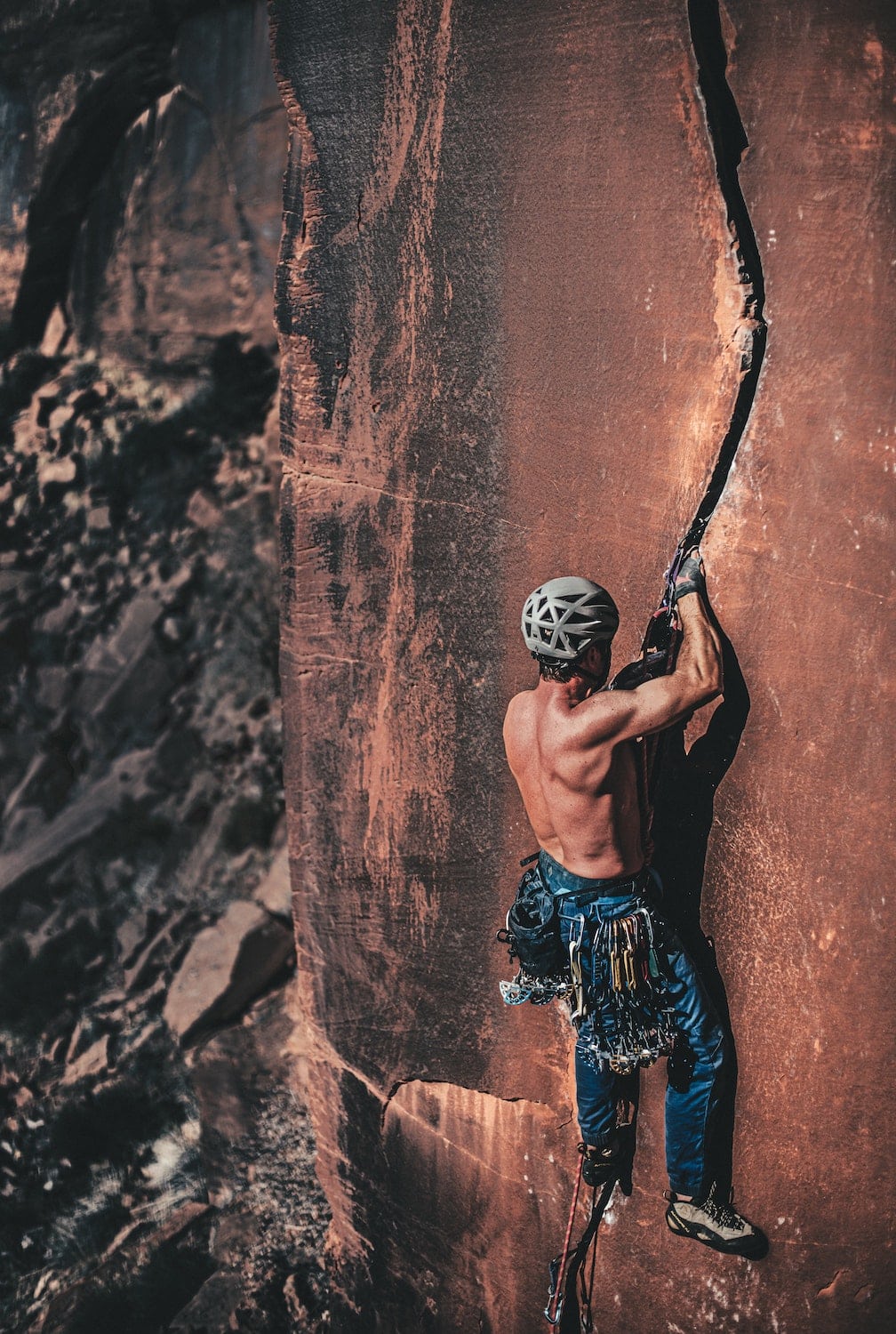
Published: 01/05/2022
Are you drawn to the mental and physical challenges posed by rock climbing? Do you admire the bold climbing heroes of yesteryear who enjoyed the mystery and adventure of first ascents to unknown summits?
If you desire to follow in their footsteps, one of the first things to learn is the rock climbing discipline known as trad climbing.
What Is Trad Climbing?

Short for traditional climbing, trad climbing is a form of free climbing where the lead climber places temporary protection equipment into cracks and other features of the rock while ascending the climbing route.
The belaying partner stands below and feeds rope to the leader as they ascend. If the leader falls, their partner stops the rope from feeding to halt the leader’s plunge.
When the leader reaches a suitable stopping point, they clip into a solid anchor before running out of rope. Their partner can climb up to join them at this stage, or the leader may lower back to the ground.
If the second climber follows up, this person removes the protective gear left behind by the leader. The two partners repeat this process, often trading the lead duties on each succeeding pitch until they reach the top.
Unlike sport climbing, trad climbing doesn’t rely on pre-drilled bolts to secure their rope for fall protection. Therefore, traditional rock climbing techniques allow you to pioneer new routes on crags and lofty peaks anywhere on the globe while climbing in the purest and cleanest style possible.
Origin of Trad Climbing
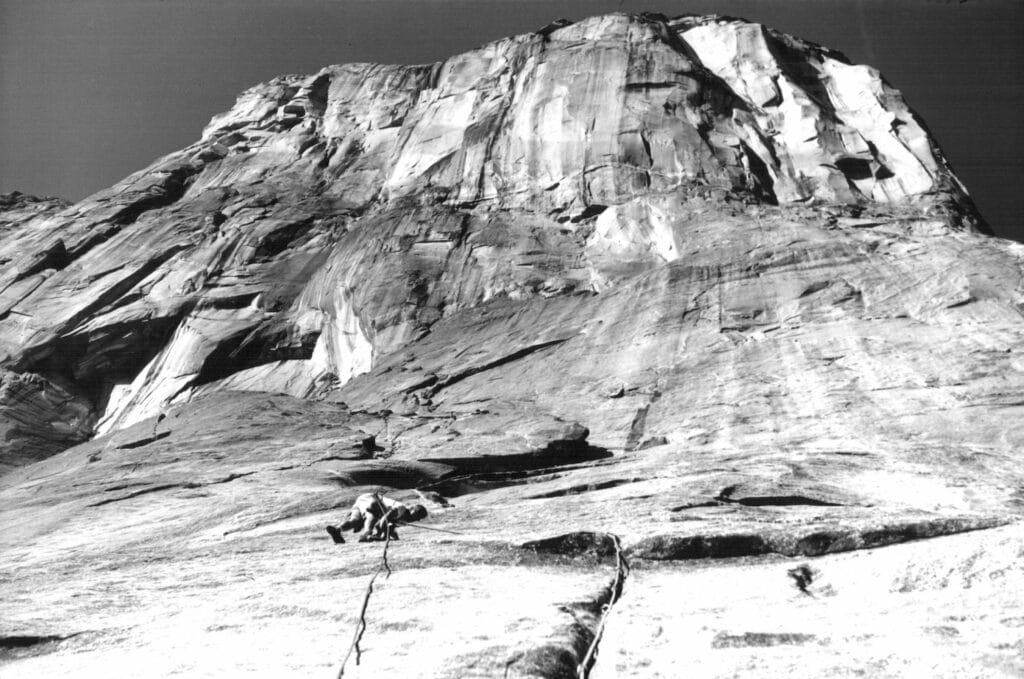
Trad climbing as a sport has its distant roots in the culture of European mountaineering, where mountain guiding was first recognized as a professional occupation in France and Germany in the early 1800s.
The tools and techniques used for mountain climbing in Europe arrived in the United States shortly afterward. At some point, climbers began pursuing not only mountain summits but also difficult, steep routes on other impressive rock spires and cliff faces.
While it’s impossible to say precisely when the current style of trad climbing began, two key elements certainly contributed.
First, the concept of climbing “free,” using only naturally occurring holds, was adopted as the preferred aesthetic of most members of the rock climbing community.
Second, the introduction of “Friends” spring-loaded camming devices (also known as SLCDs or cams) in 1978 immediately made strenuous crack climbs easier due to reduced effort placing protection. They also made many climbs safer because they can hold securely in parallel-sided cracks, where other gear provides marginal protection at best.
At this point, the term “trad” didn’t exist…one either practiced free climbing or resorted to the classic “summit by any means” ethic.
The invention of sport climbing in the 1980s made it necessary to distinguish between “traditional climbers” and the upstarts who were drilling and clipping bolts on previously unprotectable cliff faces.
Notable Climbers (Now and Then)

Before sport climbing became widely accepted, all climbers were trad climbers. In earlier eras, climbers and their gear were less specialized, and they often started their careers with alpine mountaineering.
During the 19th century, climbers and guides in the Alps were the equivalents of modern-day rock stars, climbing and dying on the Matterhorn, the Eiger’s North Face, and other infamous peaks. The thrills and dangers of climbing have fascinated the public imagination forever.
Historical Figures from Climbing’s Golden Age
It would take an encyclopedia to sort out the contributions of all the incredibly talented climbers who played critical roles in rock climbing’s evolution. For the sake of argument, here are a few who achieved some fame during the critical period of the 1950s through the 80s:
- Royal Robbins
- Warren Harding
- Jeff Lowe
- Reinhold Messner
- Jim Bridwell
- Lynn Hill
- John Long
Famous Climbers from the 2000s to Present
Trad climbers who become well-known these days earn admiration for their prowess on extremely difficult big wall routes or their success on burly single-pitch lines.
Tommy Caldwell
His well-documented send of The Dawn Wall on El Capitan is an incredible portrayal of the apex of elite climbing.
Thomas and Alexander Huber
The German brothers are famous for developing routes on alpine big walls at the highest levels of difficulty.
Jacopo Larcher
Jacopo excels at everything from bouldering to big walls to cutting-edge single pitch trad testpieces, one of a new breed of diversely talented climbers.
Dean Potter
The late Dean Potter (1972-2015) set many speed records in Yosemite and elsewhere, pushing the limits of trad techniques by mixing in simul-climbing and soloing.
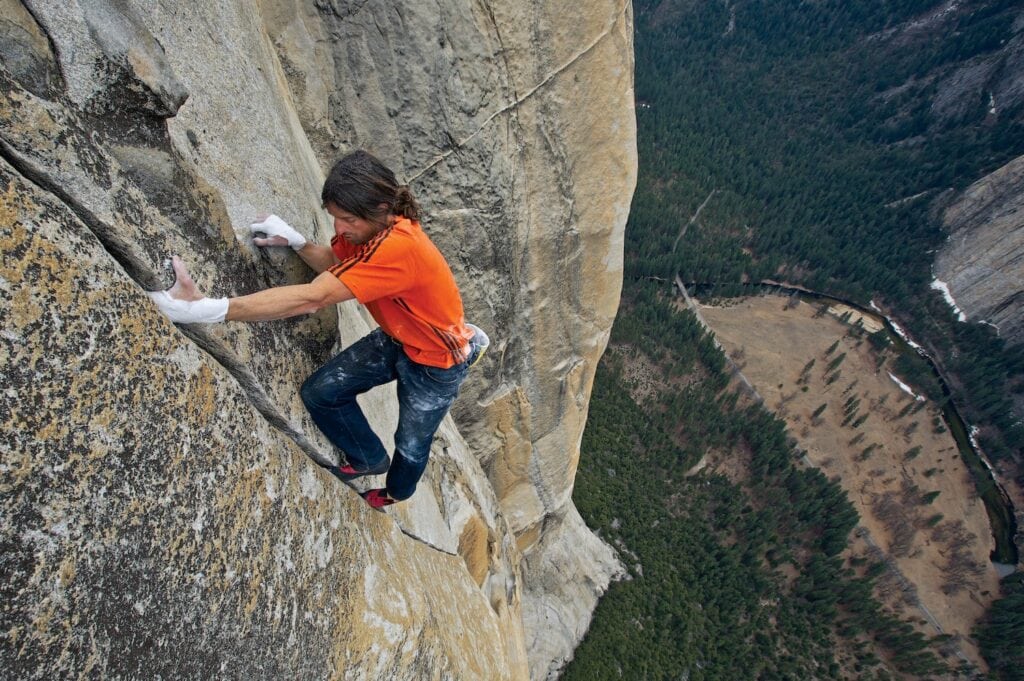
Beth Rodden
Another all-around climber who also sends some of the world’s hardest single-pitch trad routes. She was the first climber to send Meltdown (5.14c), a heinous fingertip-width crack in Yosemite Valley considered one of the hardest trad routes in the world.
Pete Whittaker
One half of the crack-loving WideBoyz team, along with Tom Randall. The pair stalks the earth seeking out the burliest, most stunning crack lines.
Differences Between Trad and Sport Climbing
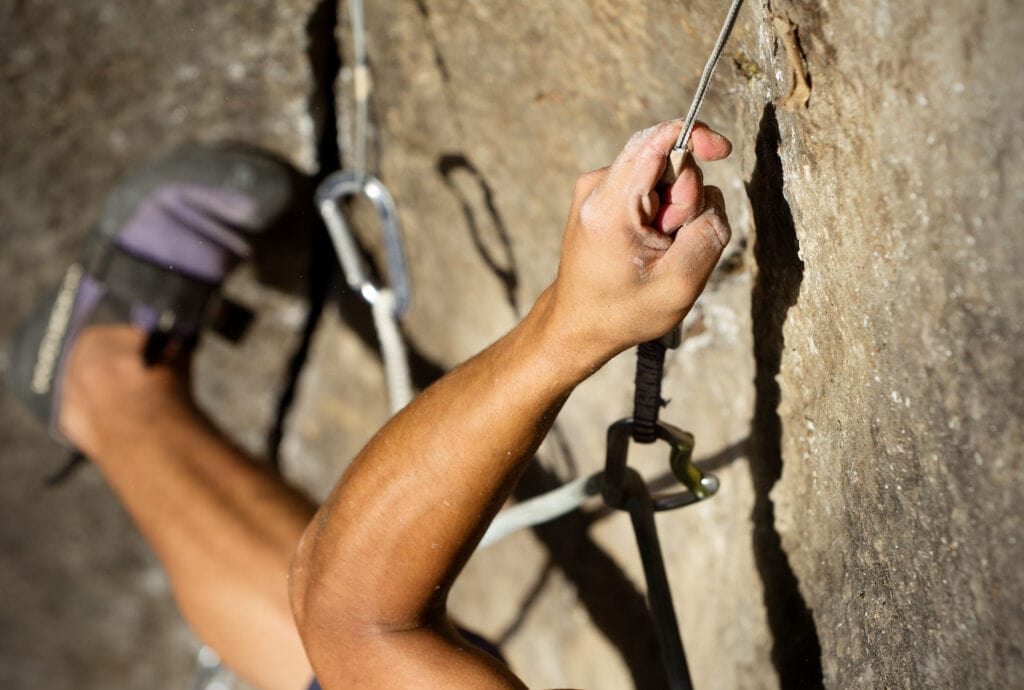
The most significant difference between trad and sport climbing is the method of protecting the leader. Sport climbers rely on pre-installed bolts for protection, while in traditional climbing, the leader places protective gear as she goes.
Aside from that, there are a few other important distinctions to consider.
Trad climbing requires substantially more gear than sport climbing. Sport climbers can often get by with a rack of 12-15 quickdraws to lead all the single-pitch sport climbs in a popular area.
On the other hand, trad racks for lead climbing consist of quickdraws, runners and slings for clipping pro and building anchors, and an assortment of protection devices (cams, nuts, hexes, and so on), a cleaning tool, and more.
In addition, trad leading and belaying demand significantly more skill and experience to maximize your party’s safety. There are more types of gear and techniques to master and many variables that don’t apply when sport climbing.
For more about how these two styles compare, see our post on the differences between trad vs. sport climbing.
Trad vs. Aid Climbing
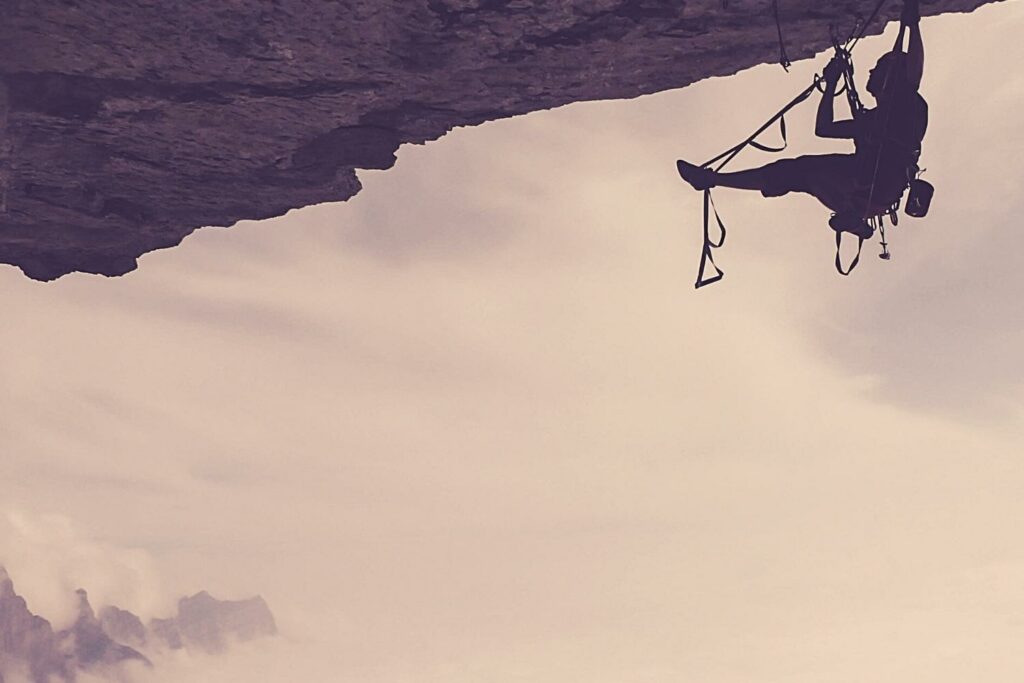
Before the advent of free climbing ethics, mountaineers and climbers generally used any means necessary to achieve their objectives. This could mean installing a bolt every four feet or using the rope and any gear at hand to assist their upward progress.
Eventually, most people who develop routes decided that less is more in terms of acceptable style. That’s especially when it comes to bolts and fixed gear (that is, gear that is installed and left behind). Most climbers now prefer to climb without pulling on their rope or other equipment. They only use natural handholds and footholds to ascend.
However, sometimes this is impossible. The only way to humanly get to the top of some blank-looking stretches of rock is with artificial assistance. This is called aid climbing, and it can consist of one move on a pitch or an entire route.
Most of the famous big wall routes at Yosemite contain at least sections where aiding is necessary.
Aid climbers use trad gear and other specialized pieces that can cling to the smallest edges and hold static body weight. These items aren’t considered safe for trad climbing purposes. That’s because they aren’t likely to remain in place in the event of a lead fall.
Trad Climbing Terminology

Cam (or Camming Device)
A protective piece with three to four metal cam-shaped lobes that rotate on an axle. They have a trigger mechanism that retracts the cams as you pull and springs that push the lobes out when the trigger is released. Pull the trigger and insert the device into a crack, and it expands to lock into place when released.
Gear Placements
It’s the specific place in a crack or other feature where the leader puts in a piece of gear. Typical gear placement is inside a crack where the rock surfaces come together to create a narrowing constriction. The term can also refer to the relative security of a piece of gear that has been placed. “How are the gear placements on that climb?”
Hex
A type of passive protection gear usually reserved for cracks that are too large to protect with nuts. As you might guess, a hex is a six-sided, hollow metal tube with a knotted cord to attach a carabiner. Cams have mostly replaced hexes on the modern trad climber rack.
Nut
A type of protection that consists of a tapered piece of metal meant to be jammed into a crack, with a wire loop into which a carabiner is clipped to attach the rope. Nuts come in sizes from #0 – #13 and protect cracks from about 1/4 inch up to 2 inches (6 – 50 mm).
Offwidth
A crack that is too large to jam your fists into but too small to fit your body. Climbing an offwidth offers a prime opportunity to invent new techniques and colorful curses.
Pitch
The portion of a route that the leader climbs before stopping to belay. Therefore, a pitch can never be longer than the length of one’s rope. Many climbs consist of only one pitch, a “single-pitch route.” Climbs with more than one pitch are called multi-pitch routes.
For more information, check out our article on multi-pitch climbing.
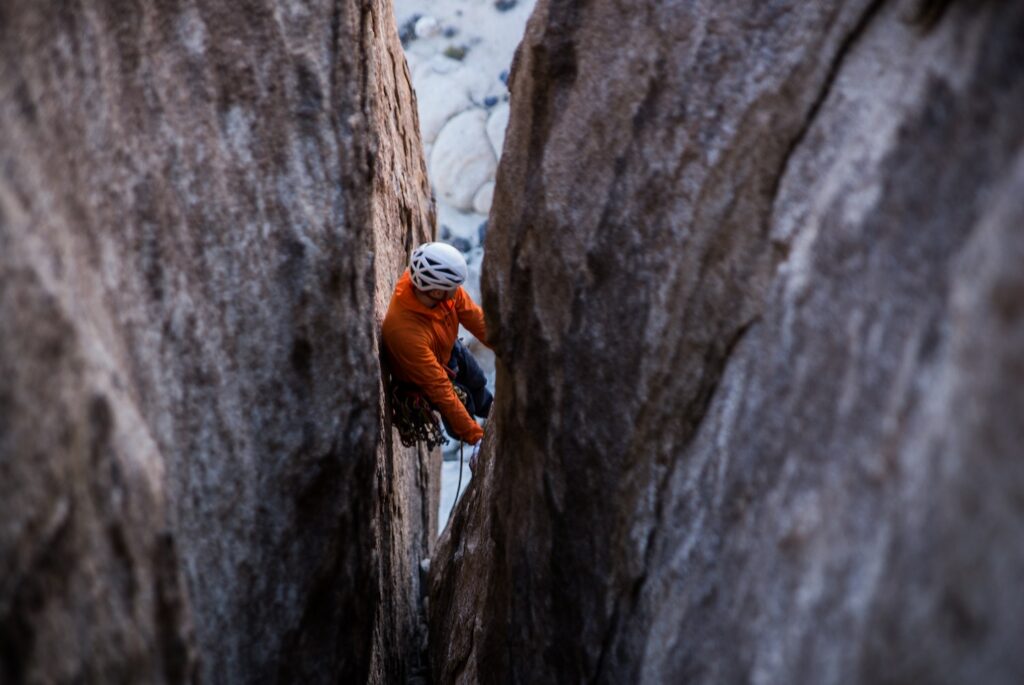
Pro
Short for “protection.” Refers to the gear placed by a trad leader to protect falls along a route.
Rack
The gear a lead climber carries on a particular route or pitch.
Runout
A section of rock on a route with no viable protection available because there are no suitable rock features to place gear. Leaders risk longer falls on runout areas.
Sharp End
The end of the rope tied to a lead climber. When a trad climber is “on the sharp end,” it implies they are leading a route and facing the inherent risks and excitement involved in that challenge.
Tricam
A type of passive protection that functions partly like a nut and partly like a cam. Tricams may protect certain features better than nuts or cams, such as pockets and shallow, horizontal cracks.
Trad Climbing Grades and Difficulty Ratings
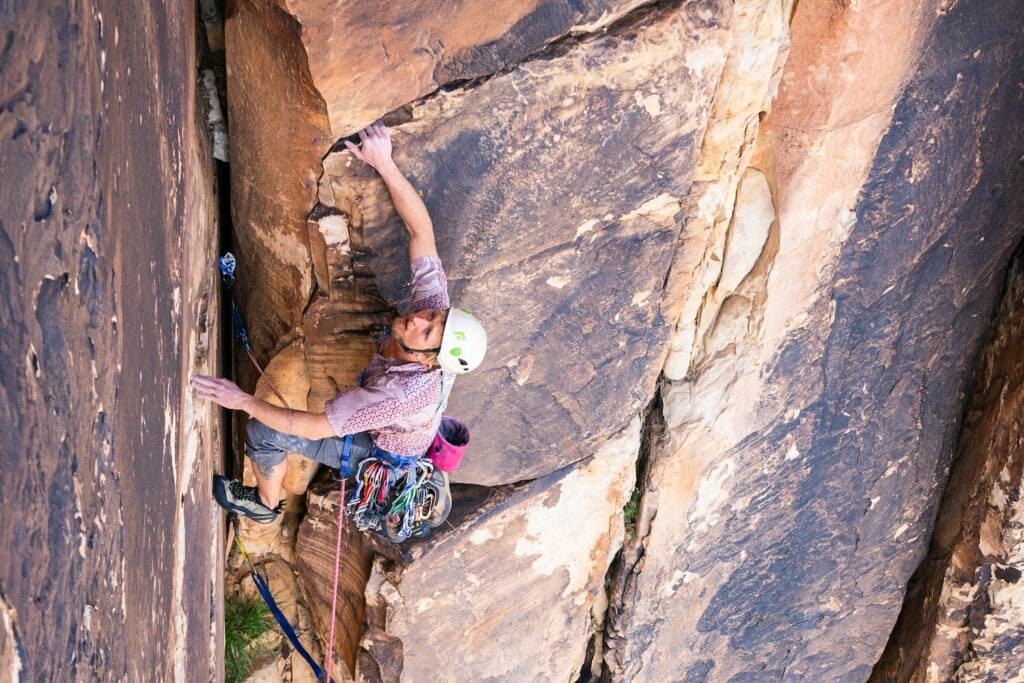
As in all climbing disciplines, climbers rate trad climbs for difficulty based on a scale system. Check out our comprehensive guide to climbing grades for the full story on ratings.
In many parts of the world, trad grades use the same grading scale as sport climbing routes. In the United States, the Yosemite Decimal System (YDS) ranges from 5.0 to 5.15d. Many other areas around the globe use the YDS, or the similarly popular French system, which runs from 1 to 9c.
An exception to this custom is the United Kingdom, where they have developed a unique trad grading system that includes two components. One part of the rating describes a route’s perceived danger, and the other its physical difficulty.
Trad Climbing: Core Concepts
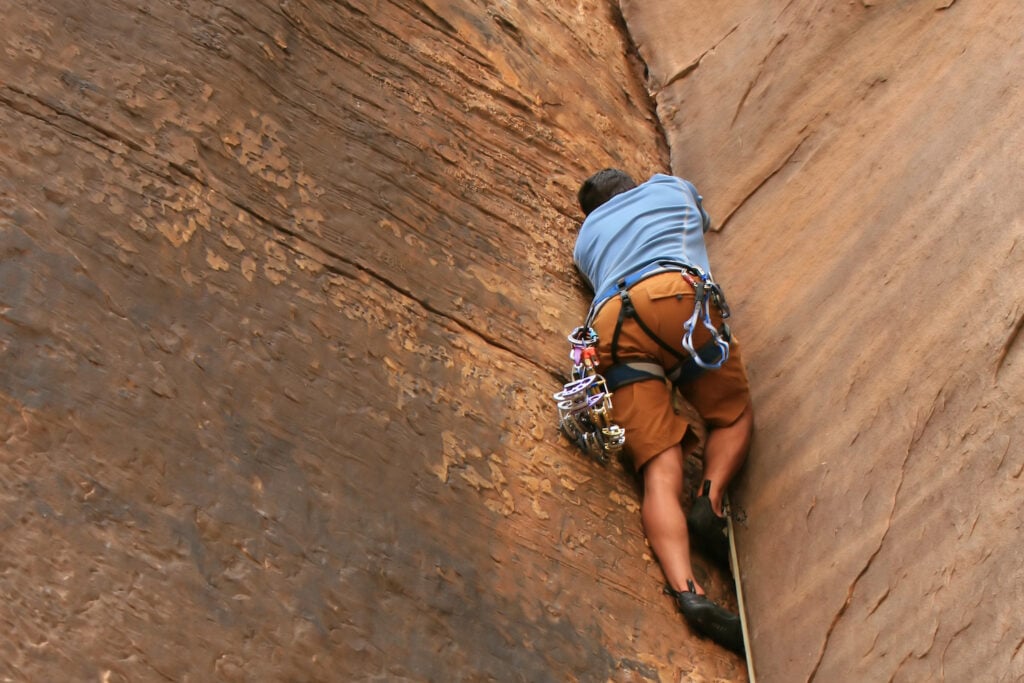
Choosing and Placing Gear
The most critical skill to learn in trad climbing is the art of placing gear on lead.
In five minutes, most people can learn the fundamental concepts of leading a sport climb in an indoor climbing gym. Tie in, clip your rope into the draws in the right orientation, and memorize a few verbal commands to communicate with your belayer.
Training yourself to feel completely confident in your abilities to protect yourself and your partner while trad climbing outdoors is nothing like that scenario. You may need thousands of repetitions of placing different types of trad gear in and on various features, on different kinds of rock.
Two types of rock features to consider
There are two general categories of rock features that trad climbers use for protection at the basic level. Features that stick out or protrude from the wall comprise one category. Features that offer an opening into the rock are the other, like cracks, crevices, and pockets.
The first type of rock feature isn’t as common on more difficult trad routes. Using this type of protection involves tying off a horn, knob, chockstone, or chickenhead with a sling and a slip knot or girth hitch.
However, more common on trad climbing routes are the cracks, crevices, pockets, and similar intrusions in the rock. The majority of protective gear on a trad climber’s rack is for these types of rock features.
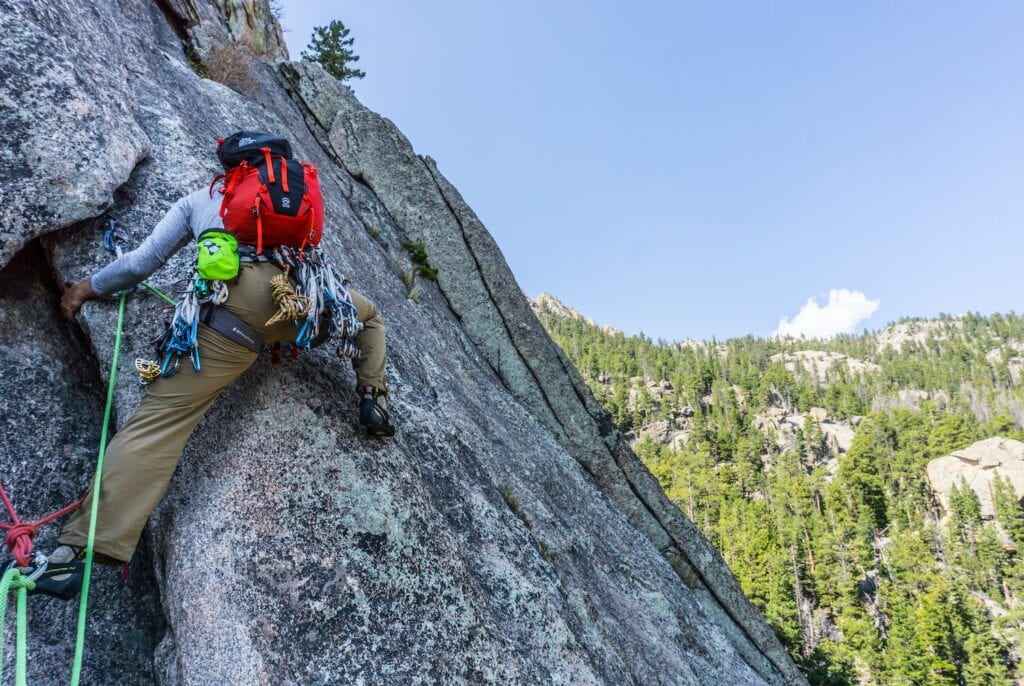
Gear for each scenario
Cams, nuts, tricams, hexes, stoppers, ball nuts, and tube chocks are all categories of gear that climbers wedge securely into cracks and pockets. They come in different sizes and shapes to accommodate a variety of features.
The most popular gear for protecting trad climbs these days are camming devices. Cams are often faster and easier to place for two reasons.
First, a single-cam can fit into a wider range of crack widths than a similar-sized nut. So, you have fewer decisions to select an appropriate-sized cam for any given crack.
Second, a cam doesn’t rely as much on constrictions or narrowing sides in a crack. So they require less fiddling and adjusting to find the ideal placement.
How To Lead a Trad Climbing Route
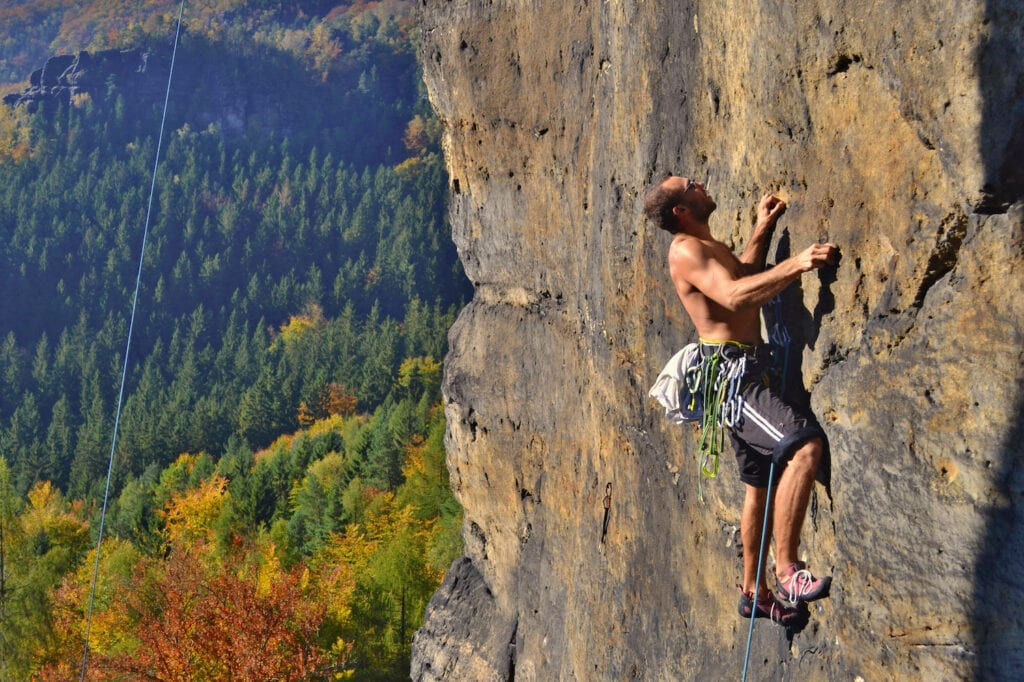
First, check your guide or other info to help determine what specific gear you’ll need on a particular route. Confirm this beta as much as possible when standing at the bottom. Take a few extra pieces as a backup if you’re not sure.
Your first goal is to avoid hitting the ground or your belayer if you fall. In light of that, make sure and get your first pieces of gear placed before you climb too far, and make sure these are bombers.
Place as many pieces as you need to optimize safety and efficiency. Too few pieces, and you risk long falls and injury. Too many pieces and you may run out of gas before reaching the top.
There’s no rule for how many pieces you need or how far apart they should be. It’s up to every trad leader to determine how much risk to accept and how likely they are to fall or to be injured in a fall. The availability of suitable rock features also dictates where and how much gear you can put in. Sometimes there are simply very few locations for solid gear placements.
Test your gear placement every time you set a piece by jerking on its runner in the expected direction of a fall. Consider rope drag and the piece’s potential to “walk” out of the crack or move as you pull the rope up. Use a longer runner on your quickdraw to avoid too much zig-zagging in the rope.
For more details, see the article by climbing guide Teddy Dondanville on how to build your first trad rack and maintain it.
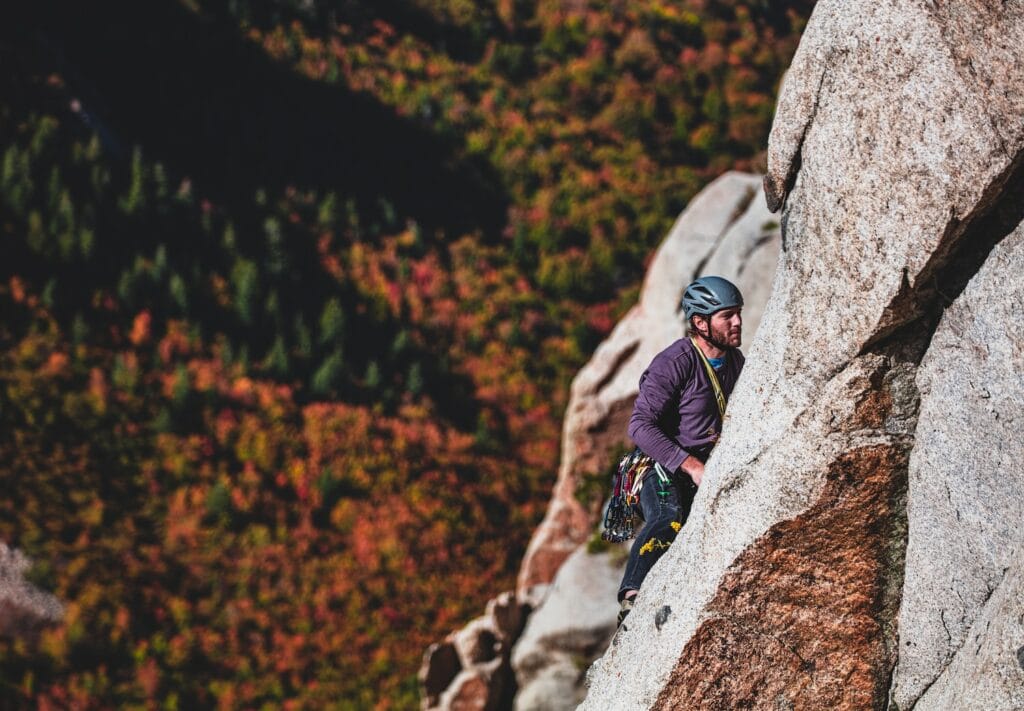
Lead Belaying
Learning to belay a leader is a fundamental first lesson when launching yourself into trad climbing. First-time trad belayers often have a background belaying sport leaders, which is a great start.
There are additional factors to consider when belaying a trad leader, though. Is the leader placing enough gear to prevent a hazardous fall? In the heat of battle, a new trad leader may be too stressed to make proper decisions.
A belayer needs to maintain a high level of situational awareness regarding all objective and subjective hazards, including but not limited to the quality of the rock and the leader’s gear, weather conditions, and his partner’s mental state.
See our complete beginner’s guide to belaying for more information.
Active vs. Passive Protection
Generally speaking, pieces of protective gear that don’t rely on moving parts to generate friction are referred to as passive. For example, nuts, hexes, tube chocks (e.g., Big Bros), and tricams.
Spring-loaded camming devices like Wild Country Friends, Fixe Hardware Aliens, Black Diamond Camalots, Metolius TCUs, etc., are called active pro. They rely on moving mechanisms with cams and springs to generate outward force and expand the cam lobes inside a crack. Ball nuts are another widely available type of active protection.
What About Pitons?
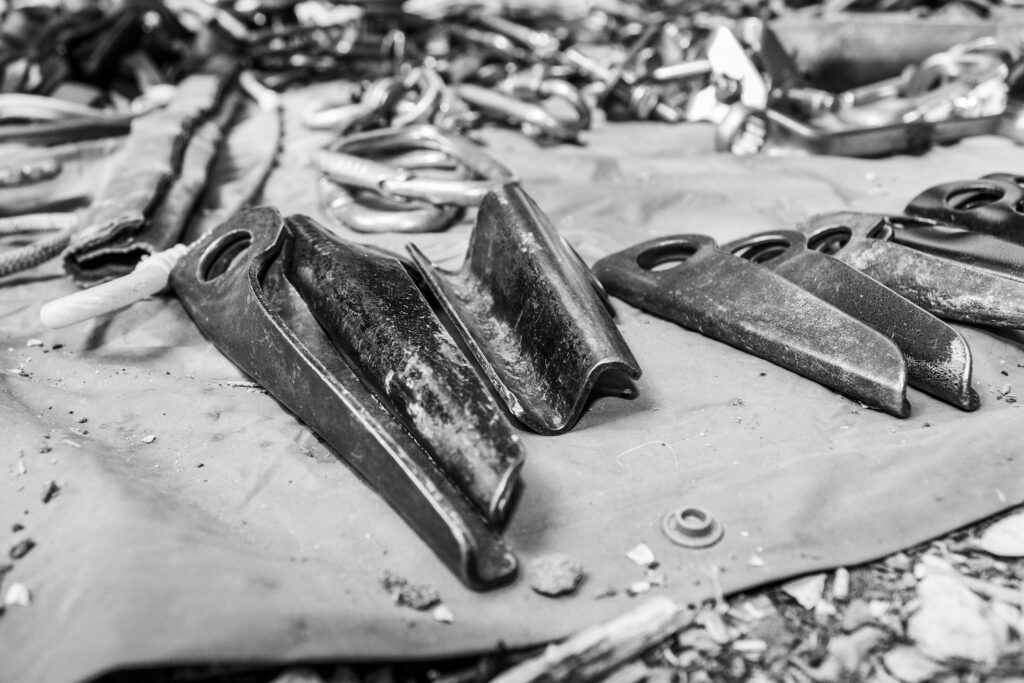
Metal pitons were developed for mountaineering in the Alps. Pitons are blade-shaped on one end, with a round eye on the other end for attaching carabiners. Leaders carry a hammer to pound pitons into cracks and crevices, then clip the climbing rope into them for protection.
Pitons have mostly been replaced on the modern climber’s rack by more easily removable gear like nuts and camming devices. You’ll find fixed, antique pitons stuck into classic climbs everywhere, and big wall climbers and mountaineers still use pitons.
How To Start Trad Climbing
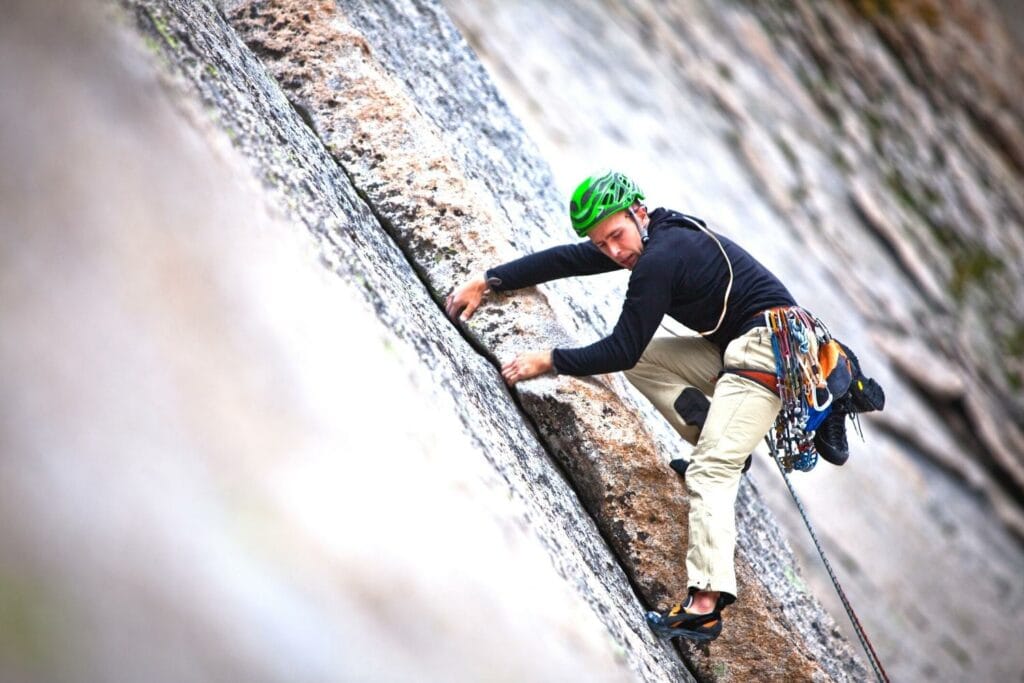
Unlike sport climbing, you can’t learn or practice trad climbing in the climbing gym. However, you might be able to meet a seasoned trad climber in the gym who is willing to show you the way.
Finding a trustworthy partner is truly the best way to learn proper trad climbing techniques. Many climbers are happy to find a new belay partner and share their trad climbing skills.
Another big advantage is using someone else’s gear before deciding whether to invest in your own.
If you live near or visit a region with outdoor climbing areas, you can also take a course from a guiding service or school. The main issue is that it takes more than a weekend of training to become proficient enough to trad climb safely.
Famous Trad Climbing Areas Worldwide
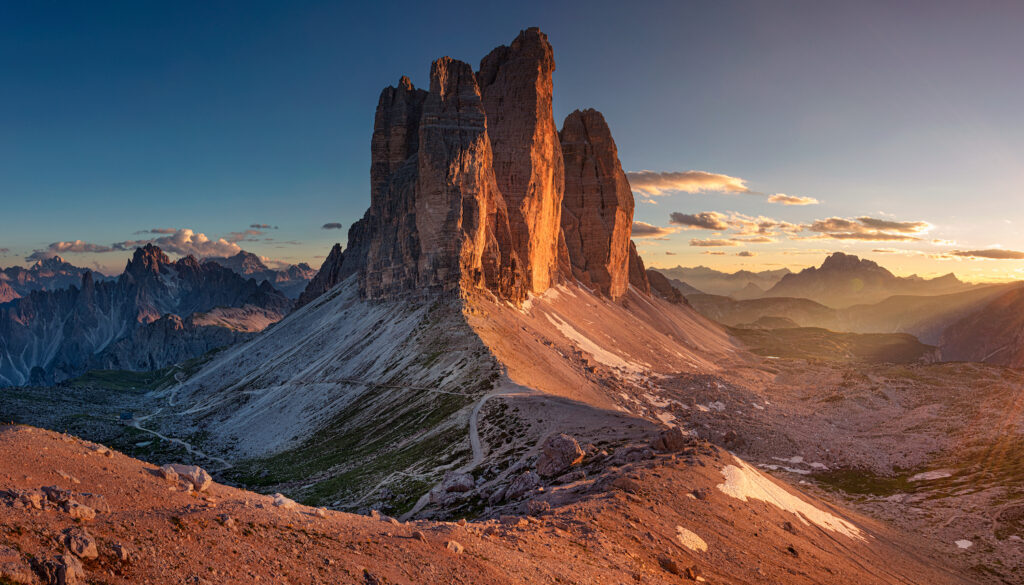
Because trad climbers aren’t relying on pre-placed protection or anchors, any rock face that accepts protective gear holds a potential trad climb. In reality, most climbers spend most of their time on rock climbs that have been previously documented.
Top Trad Destinations in the United States
- Yosemite Valley, California – The birthplace of modern trad style, spring-loaded camming devices and dirtbag culture. This is still the place for young trad devotees to learn their craft on big granite walls.
- Indian Creek, Utah – Notable for its immaculate, varnished Wingate sandstone split by perfectly parallel cracks.
- Shawangunks, New York – One of the oldest established climbing areas in the U.S. Classic, sandbagged routes on quartzite conglomerate.
- Joshua Tree, California – Desert wonderland of granite domes, pinnacles, and boulders. Winter destination.
Other Trad Hotspots Around the World
- Dolomites, Italy – A vast region of fantastic limestone pinnacles and crags, with thousands of routes up to 5,000 feet (1,500 m) in length.
- Mount Arapiles, Australia – A single rock formation that hosts over 3000 routes on bulletproof quartzite and sandstone, all within a few minutes from the car park.
- Elbsandstein, Germany – A classic region of sandstone spires and strict ethics, also known as Saxon Switzerland. Leave the chalk, cams, and nuts at home, the only types of protection allowed are slings and rope knots jammed into the cracks.
- Peak District, England – Scary gritstone test pieces with minimal protection and huge fall potential, along with hundreds of moderates in a picturesque landscape of cliffs and quarries. Stanage Edge provides a full introduction to all the Peak District has to offer.
Trad Climbing Equipment and Gear
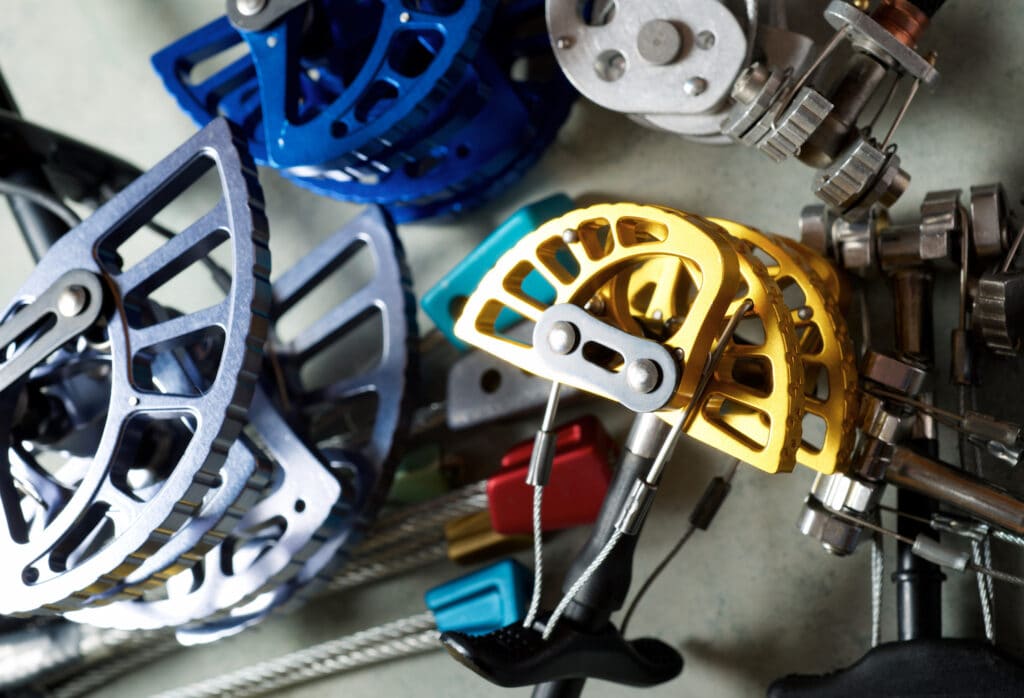
As you may have guessed, the pursuit of traditional climbing requires quite an investment in climbing gear. If you have a trusted climbing friend you may be able to borrow equipment at first, but eventually, you’ll need your own gear.
Basics
Climbers in every discipline need to carry a few of the same essentials: harness, climbing shoes, helmet, chalk bag, belay device, personal anchor system, and perhaps self-rescue/safety equipment (cordelette and sling for prusiks and rappel backups, for example).
Rope
To climb a sport route on a single pitch crag, you’ll also need a dynamic climbing rope from 60 – 80 m long, and at least as many quickdraws as the route has bolts and anchors. Sport routes typically have fixed gear at the top of a pitch to allow a leader to lower off (or rappel) without leaving their own gear.
Trad-specific gear
In addition to the above, a basic rack of trad climbing gear includes the following:
- (1) full set of cams, sizes #0.5 to #3
- (1) set of wired nuts
- (6) quickdraws
- (20) carabiners, (4) locking carabiners
- (10) Nylon/Dyneema sewn runners to extend pro and build anchors
- Nut tool for removing gear
- Supplement with micro-cams, micro nuts, larger cams, tube chocks, etc. as needed to protect thinner or wider cracks at your target climbing destination.
This describes a minimum set of gear for a beginning trad leader. In the real world, the rack you carry must match the trad routes you’re climbing. If you’re leading a crack that is 3 inches wide for 50 feet, you may want three or four #3 cams to protect that section of the route. A leader only carries what is necessary. Anything more simply weighs you down and gets in the way.
If you aim to tackle a big wall or aid climbing at some point, you’ll need even more specialized equipment. Ascenders to climb fixed ropes, a portaledge so you can overnight on the wall, pitons and copperheads and skyhooks for aiding blank spots, and a haul bag to carry all this gear.
At first, it seems complicated to figure out exactly what gear you need for the type of climbing you want to do. Be patient, it will become clear as you gain more experience.
FAQs
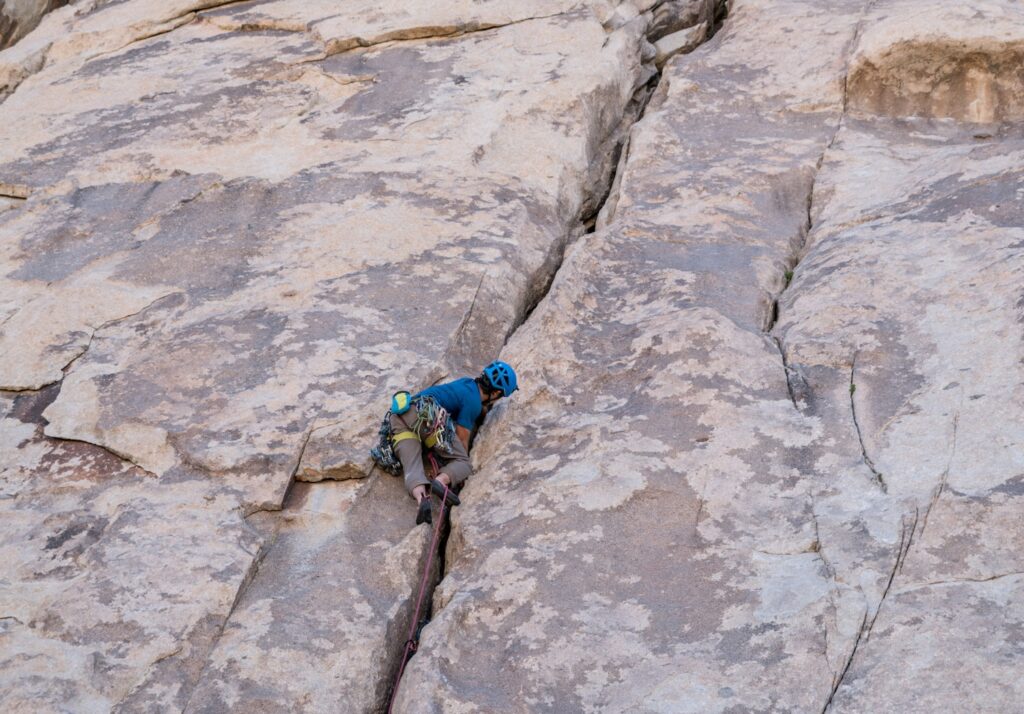
The level of risk involved in trad climbing, like most forms of rock climbing, is completely dependent on you and your partner(s). That being said, it takes a certain amount of experience to fully comprehend all the risks and how to assess and mitigate them in every circumstance. Relative to other styles of roped climbing, trad gear placements can certainly be less reliable than bolts or top rope anchors.
Compared to bouldering or sport climbing, the gear needed to trad climb safely can add up quickly. Camming devices in particular will consume a large portion of your budget, at $50-100 apiece. Expect to spend over $1000 on a full trad climbing set up if you’re starting from nothing. Fortunately, most climbing gear is durable and will last several years with a little care and maintenance.
In short, no. You can choose to tackle an easy trad climb or a hard one, based on the rating scale. Is a 5.8 trad route harder than a 5.8 sport route? In some ways, this is like comparing apples to oranges. Trad routes are more likely to require proficiency in crack climbing technique, and sport climbs tend more toward face climbing moves. Whichever you have practiced more will likely feel easier to you.
